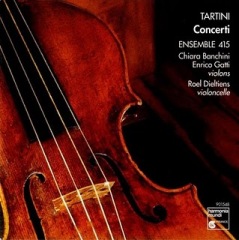Giuseppe Tartini – Concerti (Banchini) [1995]
Giuseppe Tartini – Concerti (Banchini) [1995]

1. Concerto grosso No.3 en - C Major: Grave 2. Concerto grosso No.3 en - C Major: Allegro - Adagio 3. Concerto grosso No.3 en - C Major: Allegro assai 4. Concerto pour violon et orchestra en - A Minor 'Lunardo Venier': Andante cantabile - Allegro assai 5. Concerto pour violon et orchestra en - A Minor 'Lunardo Venier': Andante cantabile 6. Concerto pour violon et orchestra en - A Minor 'Lunardo Venier': Presto 7. Concerto pour violoncelle et orchestre en - D Major: Largo 8. Concerto pour violoncelle et orchestre en - D Major: Allegro (assai) 9. Concerto pour violoncelle et orchestre en - D Major: Grave 10. Concerto pour violoncelle et orchestre en - D Major: Allegro 11. Concerto pour violon et orchestre en - G Major: Allegro 12. Concerto pour violon et orchestre en - G Major: Largo - Andante 13. Concerto pour violon et orchestre en - G Major: Presto 14. Concerto grosso No.5 en - E Minor: Largo 15. Concerto grosso No.5 en - E Minor: Allegro - Adagio 16. Concerto grosso No.5 en - E Minor: Allegro assai Enrico Gatti - violin Roel Dieltiens - cello Ensemble 415 Chiara Banchini - conductor, violin
Chiarappa plays a sweet-toned Amati from 1651, predating Tartini (1692-1770) himself. His mercurial style seems ideally attuned to the ebb and flow of the music: largos are wistful and sad, allegros darting and fanciful with the florid ornamentation tossed off like birdsong. Accademia Bizantina uses "original instruments" (the extent of the "originality" with regard to tuning, stringing, etc. is not detailed) and are well recorded by Denon. The acoustic is slightly dry and capacious, emphasizing the instruments' reedy sibilance.
The carefully inflected performances of Ensemble 415 make plain the "affetti" (state of emotions) that inform Tartini's work. The Italian violin virtuoso made frequent use of poetry to inspire his composing, sometimes even recording the affecting epigram in the score. Notes accompanying both CDs reviewed here touch on this in some detail: Harmonia Mundi has Gatti's excellent if overachieving reflections; Denon is less well off with a poor translation of a more pertinent essay by Silvia Tuja. Ensemble 415 sounds the more polished group to me, though I prefer Chiarappa to either of its violin soloists. The overall interpretive bent of 415 is one of languor and affliction, whereas Accademia Bizantina, with their rhythmic vigor turned way up ("ours go to eleven!") are positively ecstatic. Perhaps the way Tartini felt during his jam sessions with the orchestra of the Basilica of St. Anthony's in Padua. Since it is my duty to make odious comparisons, I narrowly prefer the Denon record. ---Robert J. Sullivan, classical.net
download: uploaded yandex 4shared mediafire solidfiles mega zalivalka filecloudio anonfiles oboom
Last Updated (Wednesday, 28 May 2014 19:38)








